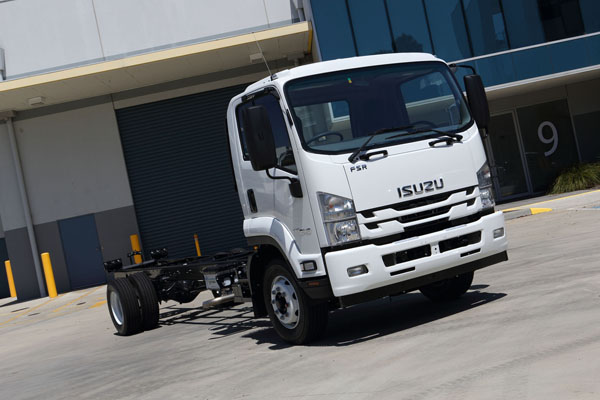From garbage and cement to refrigerated transport, Australia’s medium-duty truck market serves up a menu of applications, making it one of the automotive industry’s most competitive markets.
The medium-duty market – two axle vehicles with a gross vehicle mass greater than 8000 kg and a GCM up to 39,000 kg – made up 21.5 per cent of total commercial vehicle sales last year, with the light and heavy truck markets representing just less than 31 per cent each and vans making up the remaining 17 per cent.
With almost three decades of market domination in Australia, Isuzu is out to maintain its position with its newly released 2016 F Series range of ‘fit-for-purpose’ products with outstanding environmental credentials and substantial performance and fuel economy gains.
First impressions are of a newly-minted character with fresh radiator grille design, different badging, seat trim, steering wheel design and, last but not least, nomenclature, including FRR, FRD, FSR, FSD, FTR, FVR and FVD, FV, FSS and FTS, the widest choice for medium-truck customers.
Central to all this is what’s under the bonnet. There are two diesel engine options on offer across a 4×2 and 4×4 range. Star turn is the four-cylinder intercooled turbo 4HK1, which can lay claim to be the cleanest medium duty Japanese diesel engine on the Australian market, equivalent to Euro 6 emission standard.
The 5.2-litre unit comes in a choice of two power ratings – 154 kW and 726 Nm of torque or 177 kW producing 765 Nm of torque. The welcome power boost can be put down to a two-stage turbocharger with low and high pressure elements operating across the rev range. A bonus is the increased effectiveness of the exhaust gas recirculation system, resulting in lower nitrogen oxide output.
Now, the 4HK1 unit can be mated with the latest generation Isuzu automated manual transmission, with a larger fluid coupling and an upgrade to a full torque converter, the latter replicating take-off characteristics of a full automatic.
Big brother is the 6HK1 six-cylinder DOC motor, with diesel oxidation catalyst, putting out 191 kW at 2400 rpm and 761 Nm from 1450 to 2400 revs. With improvements to every aspect of combustion, including higher injection pressure and an increased number of ports, there are fewer emissions at the manifold and less to clean-up in the exhaust system.
The new ‘six’ with DOC powers FRR, FRD, FSR FSD, FTR and FTS models with an Isuzu six-speed manual or Allison LCT 2500 six-speed automatic transmission. It can also be had in a new model, the FVR and FVD, with ZF manual or Allison MD 3000 six-speed auto.
At 10.7 tonnes, are the FRR 4×2 (including tipper) and FRD with the new 4HK1 engine with either the TC-AMT or Isuzu manual; the six-cylinder weighs in with the11-tonne FRR and FRD, including a crew cab, with the same choice of transmissions; while the new entry-level full-size 4×2 FVR and FVD models, at 16.5 tonnes are powered by the 260 PS 6HK1 DOC.
A revised multi-information display with larger screen comes standard across the range, as does low coolant sensor, while manual models take advantage of start assist which allows easier, faster clutch take-up. All manual models of FSS and FTS 4x4s now get hill-start assist to prevent roll-back on inclines.
A passenger-side air suspension seat is fitted on the FTS single and crew cab, as well as the FTR crew cab and satellite navigation is standard on all models. Safety remains paramount for Isuzu, with all F Series models retaining cornering front lights and passenger airbags first introduced in 2013.
At the media launch in Melbourne neither DAVE the talking truck, nor anyone else, for that matter, mentioned prices of the product. Apparently these are strictly between the maker and buyer.
Isuzu has been number one in sales in Australia for the past 27 years. Even Elvis, The Beatles or Michael Jackson could not boast that.












